
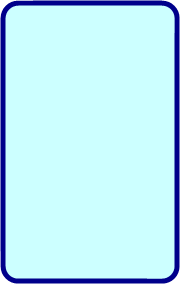
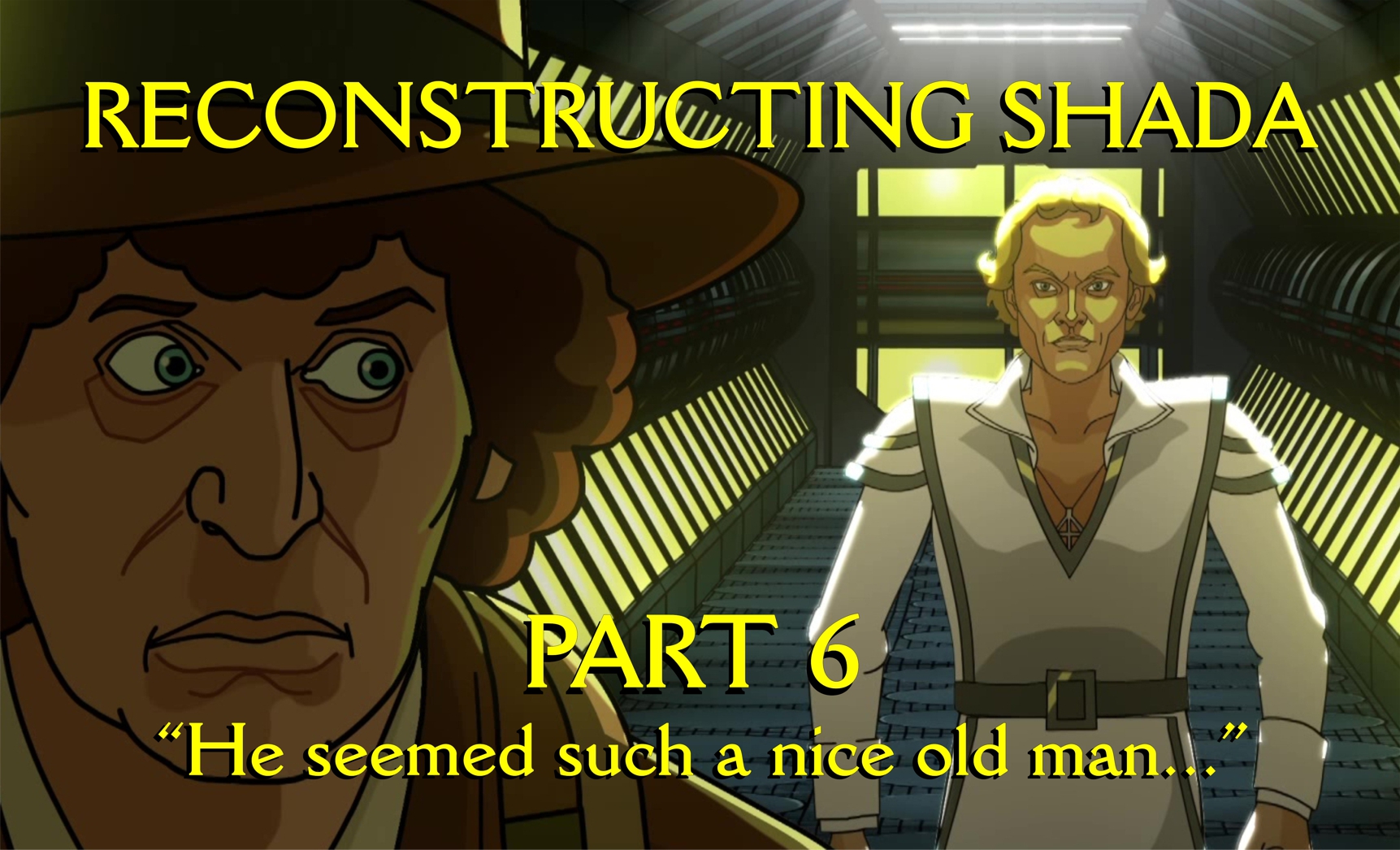
It's a bit of a non-standard camera angle for this bit of Skagra running in. We therefore shot some live-action reference footage, to help work it out. This was done, at Camberwell Studios on 6th June 2017. Tim Bentinck played Skagra for this. We were in Camberwell's largest studio (Studio 1) and in order to get this shot, John Kelly had to take the camera up the stairs at the back of the studio and up toward the roof, to look down onto the studio floor on a short lens. Frames from the footage were then given to Martin Geraghty to draw the bespoke character art for the scene. Martin also storyboarded this scene.
The footage itself went to animator Ana Garcia Sebastia so that Skagra's movement could be based upon it. The audio of this scene (with Chris Neame) was recorded on the evening of 26th June 2017 at Motivation Sound. It was the very last scene we recorded that day and (by implication) also the last bit of animation dialogue to be recorded for the production as a whole.

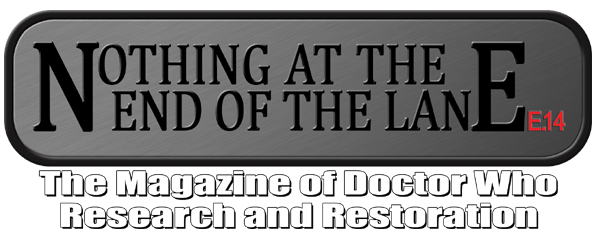
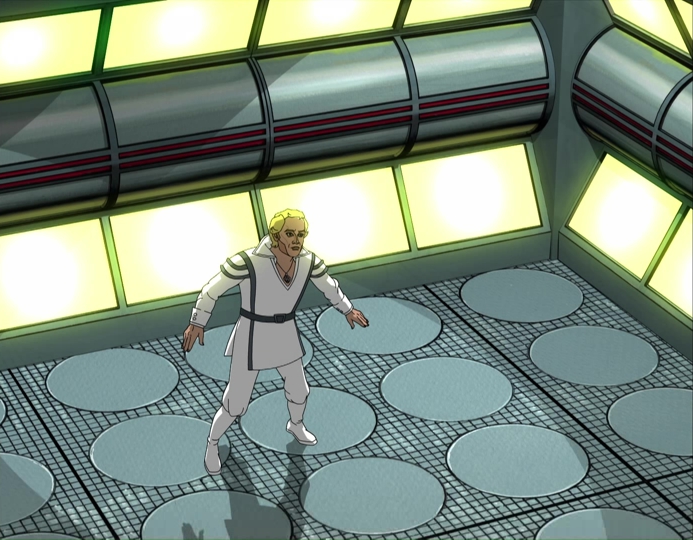
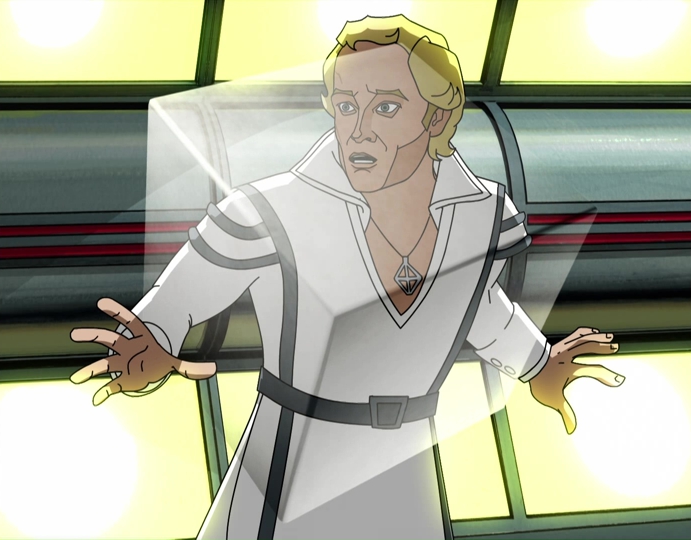
at Camberwell Studio, 6th June, 2017
This scene and the one that immediately follows it are the opposite way round in the original rehearsal script. The script has Skagra appearing back on his ship, followed by the scene of Chris on the floor. In the final edit, we swapped the scene order round, so we get Chris' scene first and then Skagra's scene.
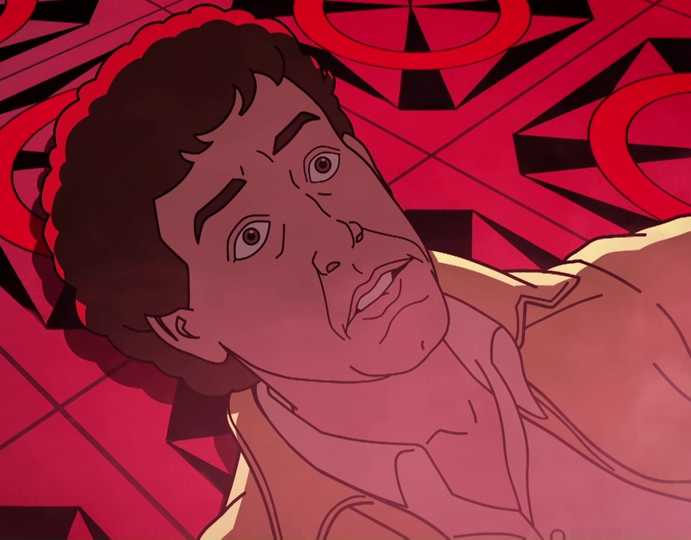
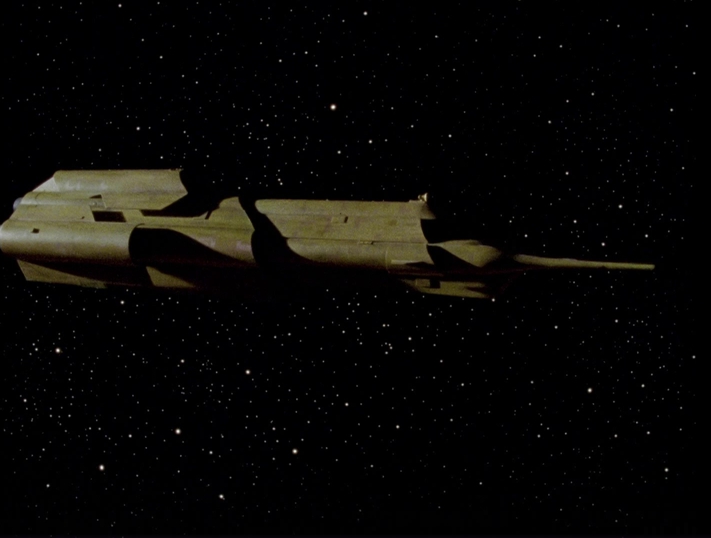
This shot wasn't actually designed to be used. It's a camera test that we filmed at Halliford Studios when we were lining up an earlier set-up. It's why the lighting is so dark.
However, although unplanned, I rather liked the way the shot looked - as if the ship was dormant. So, I added it in here. It helped ease the transition out of the last block of animation and into this final block of live action. It was only after I locked the edit that I glanced through Pennant Roberts' scripts and saw that he'd actually planned to insert a similar shot at this point himself too. Although his would have been shot on video instead of film.
Following this scene (at 2:11:59) BBC America went to their final commercial break. Following that last batch of adverts there were no more commercials until after the programme finished.
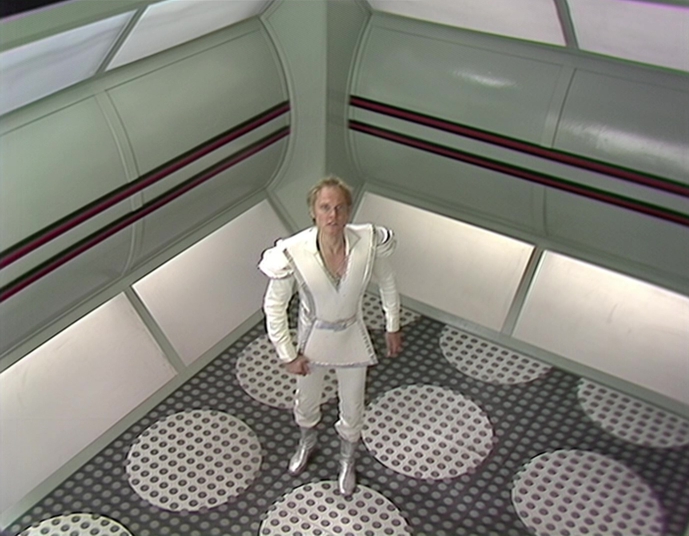
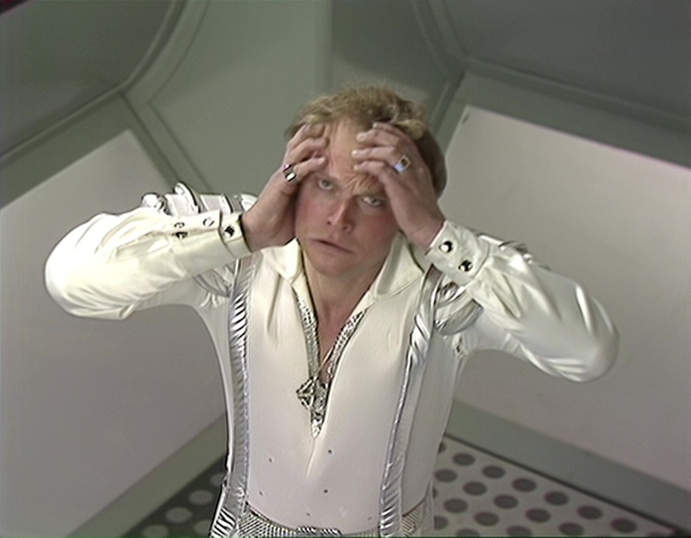
This scene of the ship saying how wonderful the Doctor is, is the one and only scene Shirley Dixon actually recorded during Shada's original production block back in 1979. She's been hired to play the ship in a number of scenes throughout the story. However, when production was suspended in November 1979, this was the only scene she'd actually completed. The rest of her material was due to be recorded later in the month, except that didn't happen.
When it came for Shirley to finally resume the part in 2017, she gave a wonderful performance. However, as you would expect, her voice had changed a little over the intervening years. So much so that the voice/over track Shirley had recorded in 1979 for this last scene sounded like it had been recorded by a completely different person. It didn't match with any of the other scenes in the story at all. To avoid the effect of the ship's voice radically changing for her final scene, we therefore decided to re-record all of Shirley's dialogue in this last scene from scratch. In the final dub, all of the 1979 audio (what little of it there was) was replaced with a new performance from Shirley of the same lines, recorded on 26th June 2017. As with James Coombe's Krarg audio, this was all done from an isolation booth and not in the main studio space, used by the rest of the cast. This allowed us to more easily manipulate the vocals of the ship in post. As a side-note, the video of this scene, was the very last thing Chris Neame shot for Shada prior to production being suspended in November 1979.
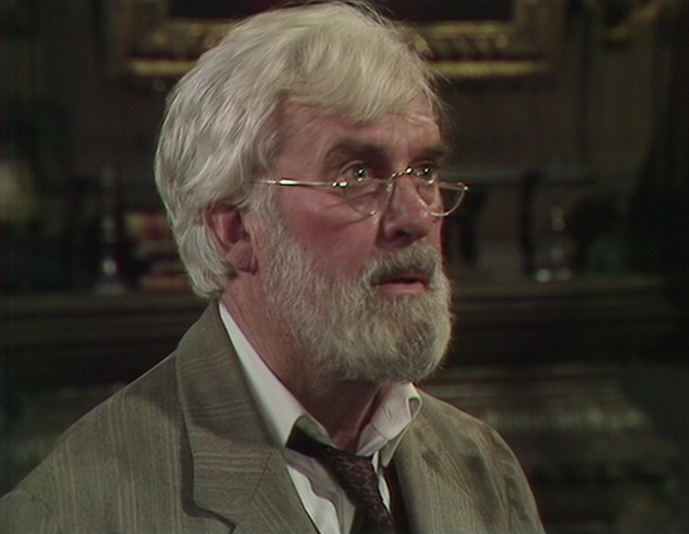
That final shot of Chronotis, glancing back while holding the tea-tray - that is the last bit of 1979 footage we use in Shada. It was also briefly planned to be the last shot of the story. In 1980, when production on Shada was briefly set to be remounted for a 1981 transmission, this scene was planned to close out the fourth and final episode. So, this is where the end credits music would crash in.
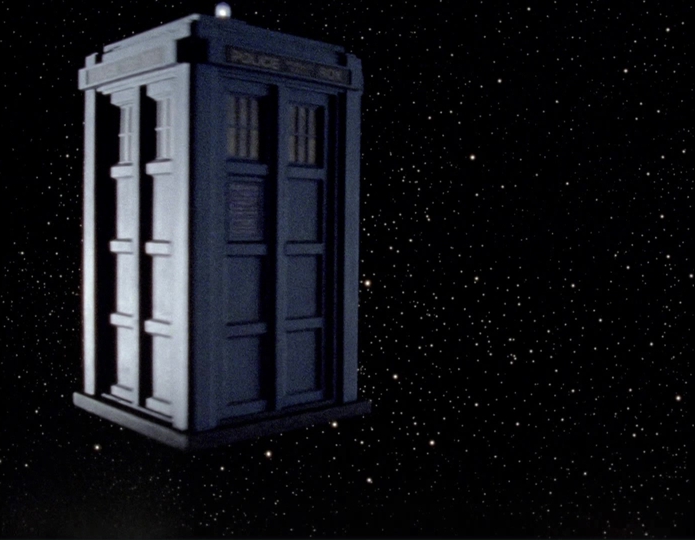
This shot was filmed to disguise the join between the previous VT scene (shot using an EMI 2001 video camera in 1979) and the next VT scene (shot using an Ikegami 79 video camera in 2017). Both video cameras were contemporary to each other. However, the images they produced were different enough for there to be a visible jump if we cut directly from one to another. As I wanted the join between 1979 material and 2017 material to be as seamless as possible, a bridging shot became pretty much essential.
As with all the other Police Box exteriors we did, this one was filmed on the stage at Halliford Studios, by Mike Tucker and his team. It's designed to look very similar in appearance to some of the TARDIS exteriors that visual effects supervisor Ian Scoones filmed for Doctor Who in the mid-1970s, on stories like Pyramids of Mars (1975) and The Masque of Mandragora (1976). It's also a really lovely parting shot for the TARDIS and caps off what had been a magnificent contribution from the Model Unit.
• MARTIN GERAGHTY:
One of the great things about working on these projects is having access to the rushes and works-in-progress that get uploaded on a daily basis, I can often lose a couple of hours on booting up my laptop in the morning, just looking at what has been delivered. The model work Mike and his team did was a real joy to delve into, completely in tune with the existing footage but with that extra sheen of his craftsmanship and what should’ve been achieved at the time. Watching these films coming in was one of the highlights of the process, for me. The multi-media aspect of recreating Shada was one of the most gratifying elements of the job and unique in these animated recreations.
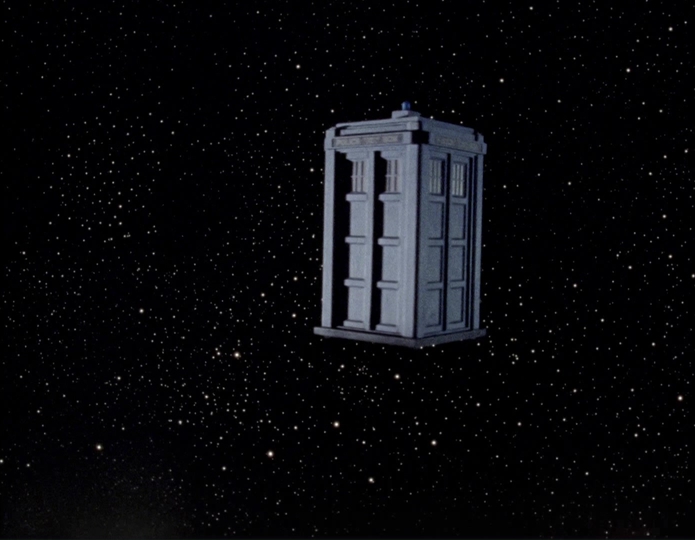
Okay, quite a lot to say about this scene, as you can probably imagine. So bear with me. This is going to take a bit of unpacking.
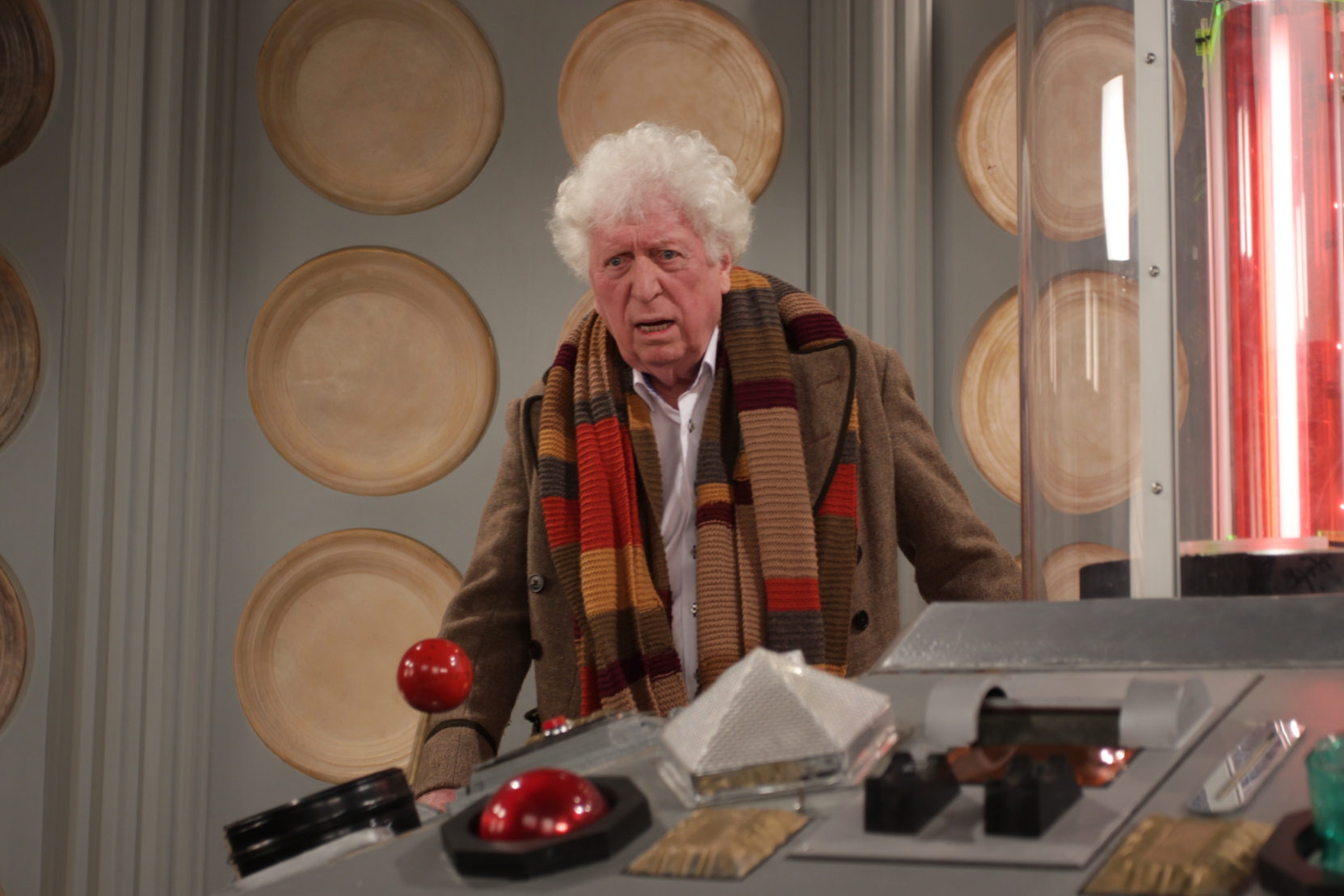
The following year, when work on the production (briefly) resumed, it was decided to scrap entire idea of a final TARDIS scene altogether and just end the whole story a scene early. Of course, none of the main decision makers involved in any of this are around anymore for us to ask why they deleted the original version of the scene and then substituted it with a much less interesting scene, only to then delete that too. However, clearly there was some quandary about how they wanted to end Shada. Conversely, in 2017, that final scene was one of the very few parts of Shada I had no doubts about at all. I knew exactly what I wanted to do with it. In fact, it was the one thing that had made me want to do the production in the first place.
Many years ago - probably more than a decade ago - I read the rehearsal script for Shada and it seemed to me that the Doctor's talk at the end about growing old presented an interesting opportunity. Why not just shoot the scene with Tom Baker as he is now? Effectively, he now is the old man that the Doctor is talking about in the scene. It was obviously never intended for the scene to work this way and it doesn't make any narrative sense, but it certainly seemed to make emotional sense. Something that didn't just conclude the story, but helped to celebrate Tom's entire time in Doctor Who. As this was the final Doctor Who story of the 1970s, this was something that could give something of a poignant send-off to that entire era of the show. A warm and reflective goodbye to seventies Doctor Who and the man that had largely come to define it.
Of course, crucial to it working would be that the audience could not know anything about what they were about to see, until the very moment that they actually see it. So, the join between old and new footage had to be managed very carefully. We shoot only on 1970s era video cameras. We start with the Doctor obscured under the console and only very slowly tease the viewer into the reveal. My original idea was actually to include Lalla Ward on screen too. So, you'd hear Romana talking off camera for a bit, then you'd see Lalla briefly pop her head around the door for her last line. And that would be your first big clue that something odd was going on. Then, just as Tom starts talking about being an old man, we cut to him getting up from behind the console, in full costume and as he is now. And he gives one of those massive grins to camera, as only Tom can. And with any luck, the audience all burst into tears. That was the plan anyway. In the end, it didn't quite turn out like that, but we got as close as we could.
It wasn't until 2016, that I broached Shada as a possible project for BBC America and BBC DVD. My executive producer (Paul Hembury) liked the idea and we decided to see what we could do to take it from there.
The first step was to make sure that Tom Baker would actually be interested, of course. So, on 6th February 2017, myself and Paul Hembury squeezed into an especially tiny glass-walled meeting room at Television Centre and we made a call. The room was just big enough for two chairs and a table, with a telephone on it. We rang Tom at his home in Sussex and put him on speaker phone, so that we could both talk to him. I did my pitch: "We cut from the 1979 footage, to what looks like some more 1979 footage. But it isn't. You rise up into frame and deliver Douglas Adams' lines from all those years ago. And it's you as you are now. You grin straight into the camera and then the music crashes in. We don't tell anyone about it. No pre-publicity. It just comes out of the blue at the end of the story." He loved the idea. And most of all he loved the effect he thought the surprise would have on the viewer.
Things started to come together quite quickly after that. And the entire rest of the project was really spun off around this first central idea of the surprise ending. We shot the scene (amid great secrecy) at IMG Studios in Uxbridge. And indeed, this scene was really the main reason we hired that studio space at IMG. Even though we shot other material on the same day, the TARDIS scene was a primary motivation for being there. We wouldn't have gone to the same lengths otherwise. We did our best to tell as few people as humanly possible. In fact, most of the brand team at BBC Worldwide didn't even know about it. Paul was exceptionally good at keeping us all very carefully insulated here and helped make sure that only those who needed to know about it were told about the shoot.
As previously mentioned, the closest period VT camera we could find to what they had used in 1979 was the Ikegami 79. Dicky Howett brought two along, I believe. However, we only used the one. The other was essentially just a back up in case the first one went bang. The camera did not go through the studio gallery, which was set-up with rather more modern cameras in mind. We instead set-up our own little gallery on the studio-floor itself, with some folding tables.
The camera was mounted on a period Vinten pedestal, with the cable feed going through two CRT monitors and into a VT recorder (manned by our chief of all things video, Peter Crocker). We had a back-up digital recorder, taking an additional copy of the feed. However, our main feed was going to a videotape recorder. We recorded to Digibeta tapes throughout. This had a nice tinge of authenticity to it - recording on actual tape, as opposed to a hard drive. However, it wasn't just for sentimental reasons that we did it this way. There were sound technical reasons too. Having a tape master made it easier to put the footage through a PAL Transform decoder, which was essential in minimising cross-colour in the video. Without that, there was a danger that our new footage from 2017 would look actively fuzzier than our old footage from 1979.
The camera is not quite as good as I'd have liked it to be, to be honest. The tubes aren't great and they're much smaller than you'd have on something like the Link 110. However, they don't manufacture new tubes anymore, so it's about as good as you can get now.
The other key part of recreating the right look for our scene was the lighting. Throughout Shada we had used (wherever practical) incandescent lighting, rather than LED light and fluorescent tubes. This had really helped match the colour temperatures of the period, when we were filming at Halliford Studios. However, with the VT shoot, things were a little more complicated. The VT scenes on Doctor Who in the seventies were never shot on a sound stage or in a film studio. They were shot in a television studio. And a television studio and a film studio are very different things. We needed an overhead lighting rig and a lighting control desk of exactly the kind that would have been used in 1979. The obvious answer was simply to return to Television Centre studio TC3 - exactly the same stretch of studio floor on which Shada was shot back in 1979. However, this proved impractical. TC3 was already booked for a game-show that week, so we went over to IMG Studios in Uxbridge. We brought in Martin Kempton as our lighting supervisor. Martin is a veteran BBC lighting director, who has worked on Top of the Pops, To the Manor Born, One Foot in the Grave, Only Fools and Horses, The Vicar of Dibley, Little Britain, Yes Prime Minister, Miranda, Inside Number 9, Not Going Out and many more besides.
Back in 1979, the TARDIS scenes for Shada were originally planned to be shot quite early on in production. Had all gone to plan, they would have been recorded on the very first day back after production was first shut down in November. The TARDIS sets even got as far as being erected on the studio floor, even though nothing was ever shot on them. As a consequence of this, all of the original 1979 lighting plans had already been drawn up for how the TARDIS scenes would have been lit had shooting gone ahead in November 1979. These plans were passed over to Martin Kempton. And Martin worked together with Console Operator Stephen Emmett to match his lighting to the plans as much as was practical.
Although we weren't going to use the main studio gallery for the studio shoot proper, it was still connected up. And on the day of recording, myself and Mike Tucker went up there, just to see how the lighting looked on the monitor banks. It really was a very good match. The little way the lighting behind the roundels sort of blew out slightly on the monitor, was absolutely spot on.
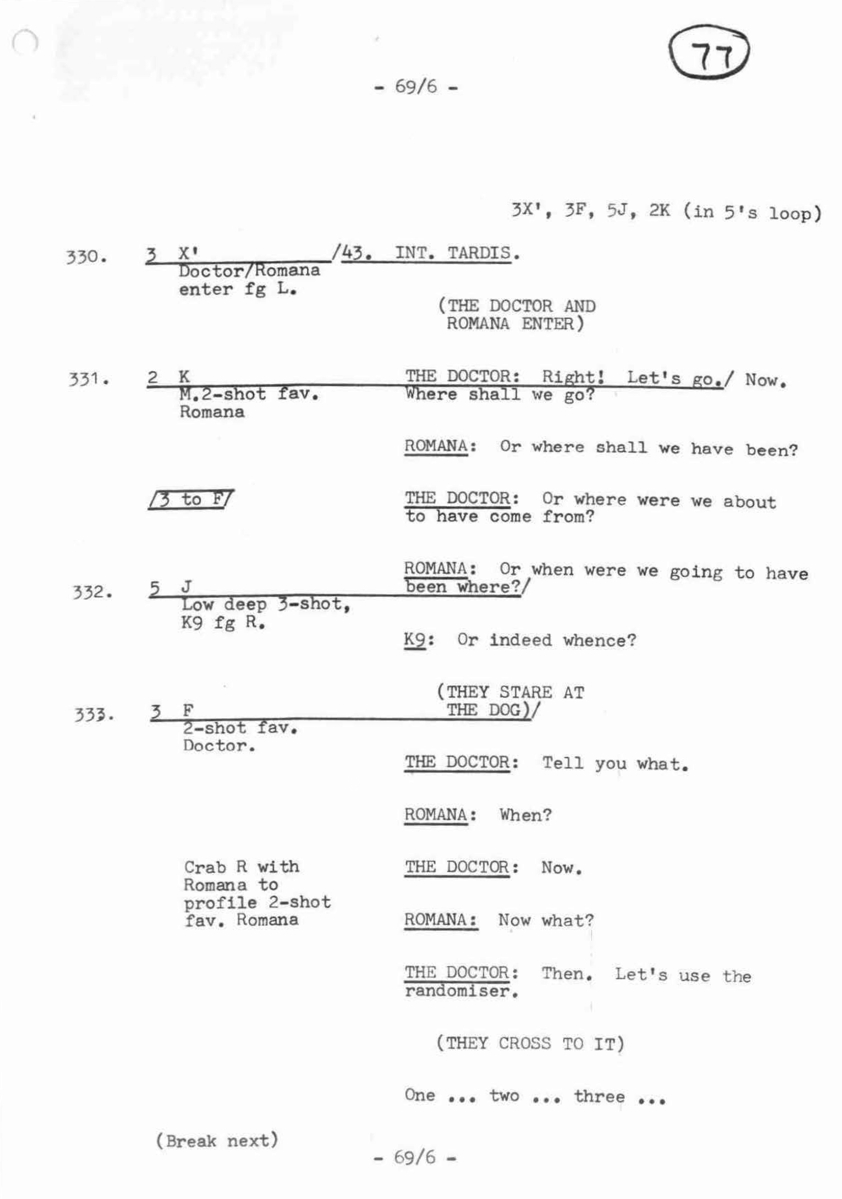
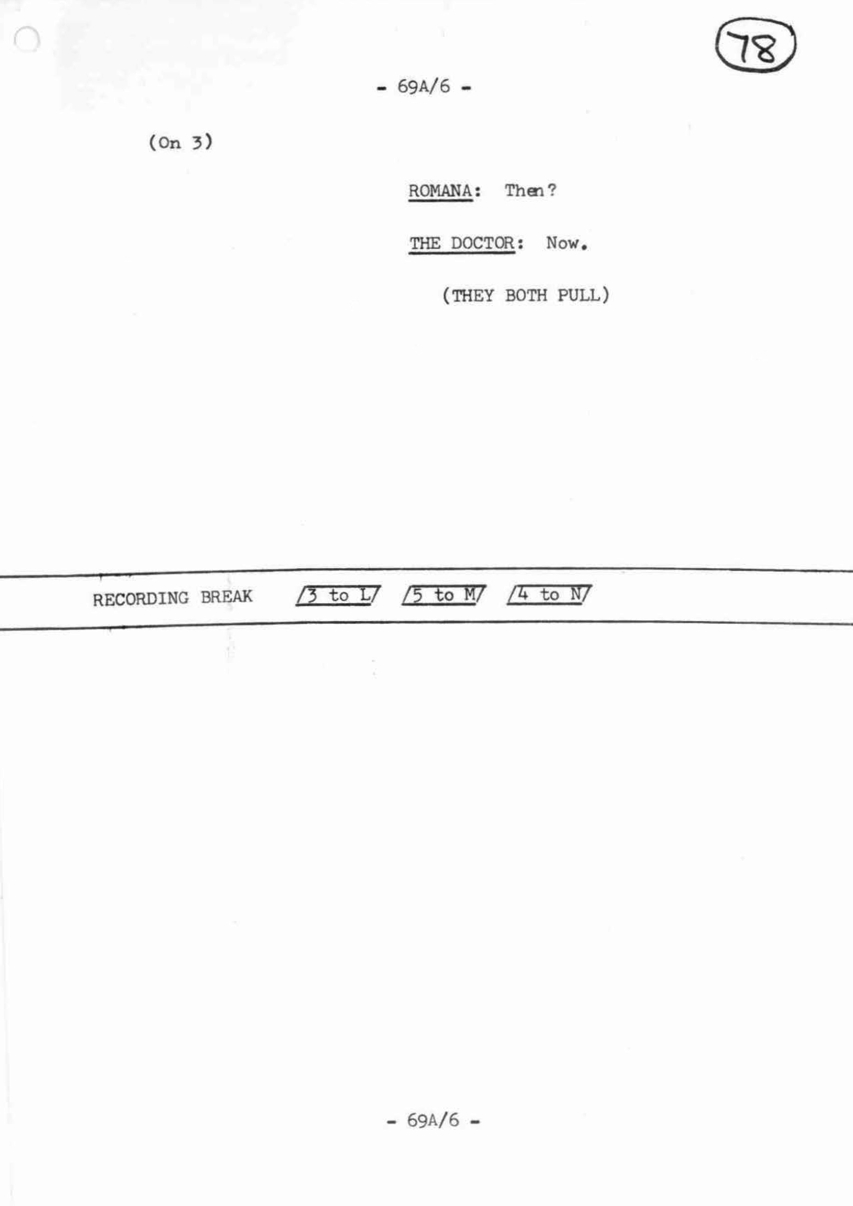
The rewritten final scene as it appears in the camera script
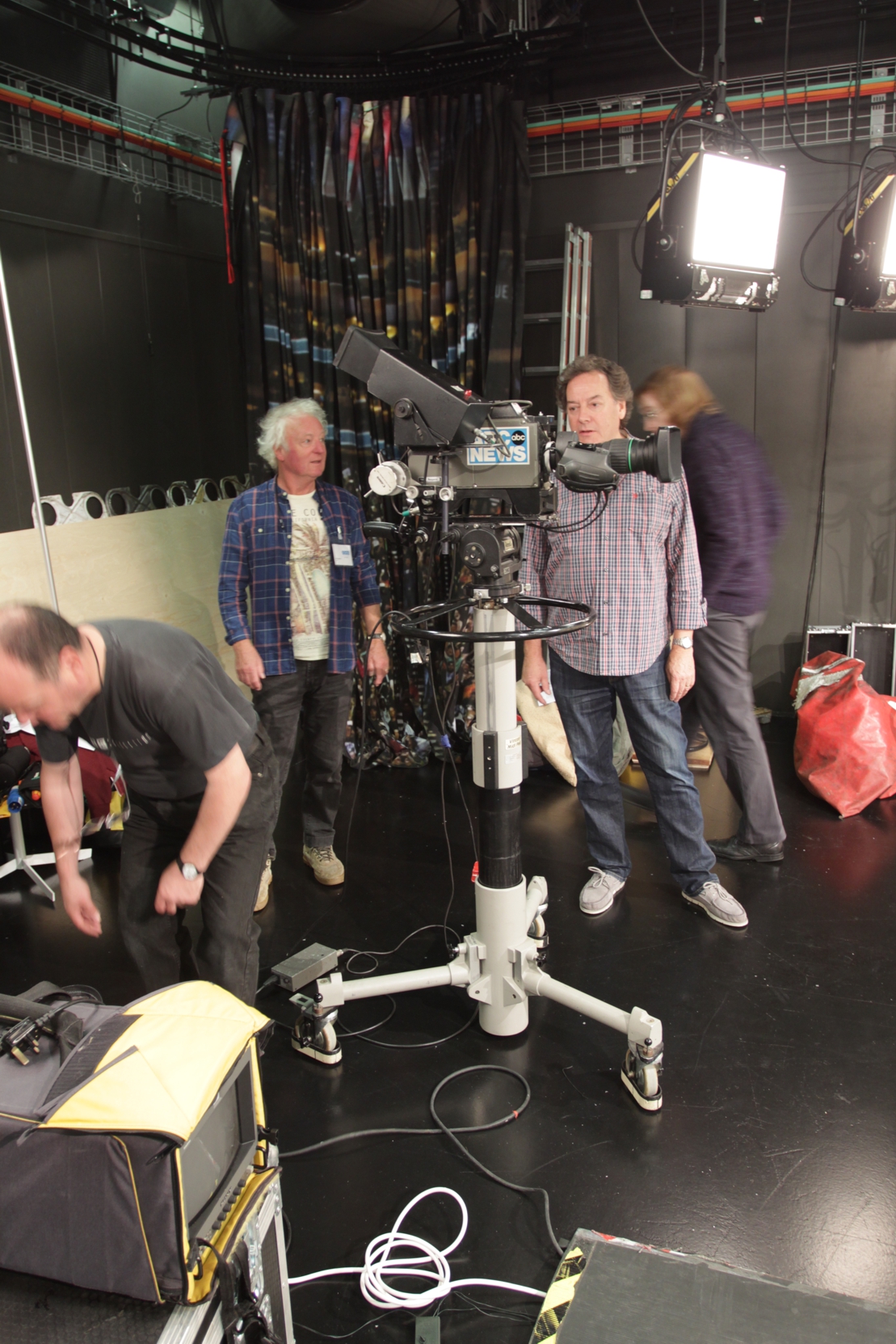
By combining the wall panels from Mark's set with the panel's from Kevin's set, it gave us enough for us to build out all we needed. From memory, I know that Kevin provided the scanner screen section, which I think he may even have built specially for us. However, after all this time, I can't remember which of the other wall panels belonged to who now. It was a mix. I think they were mostly Mark's, with Kevin's used to carry us over more toward the door. We did consider using Kevin's console build too. It was a much crisper looking build than Mark's. It wasn't quite so battered and weathered, as it hadn't been on display for as long and hadn't been mauled about with by quite so many fans visiting the exhibition. However, in the end, it was the console's very neatness and excellent build quality that actually counted against it.
By the time we reach 1979, the original TARDIS set was really very battered and rough round the edges. It looked like it had been thrown off the top of a tall building most of the time. In some episodes, you can see the tape holding it together. On these grounds, if nothing else, Mark's console fitted the bill perfectly. It just looked a lot more bashed about and tatty, which was exactly perfect for the period. Of course, how much of this was the product of careful weathering by Mark and how much of it was down to some nasty individuals giving it a kicking when they visited the Doctor Who Experience, we shall never know.
They were actually shutting down the exhibition in Cardiff the same week we needed to borrow the set components, so the timing worked quite well. We paid a quick preliminary visit a few weeks before (along the way, bumping into Peter Capaldi on his very final day of shooting on Doctor Who) and once we had measured up, Mark picked up the set the day before we shot the scene with Tom. We erected the set at IMG that day (with Mike Tucker helping with the construction) and lit it the following morning on the day of the shoot. I recall the floor was tricky to get right. We were originally going to paint the studio floor grey, to match the 1979 TARDIS. However, it was hard to make sure we had the right colour match. So, in the end, I bought a roll of grey linoleum of the right colour and we built the set on top of that. I think Kevin's still got that lino actually. He took it away with him at the end of the day, to save us having to hire a skip.
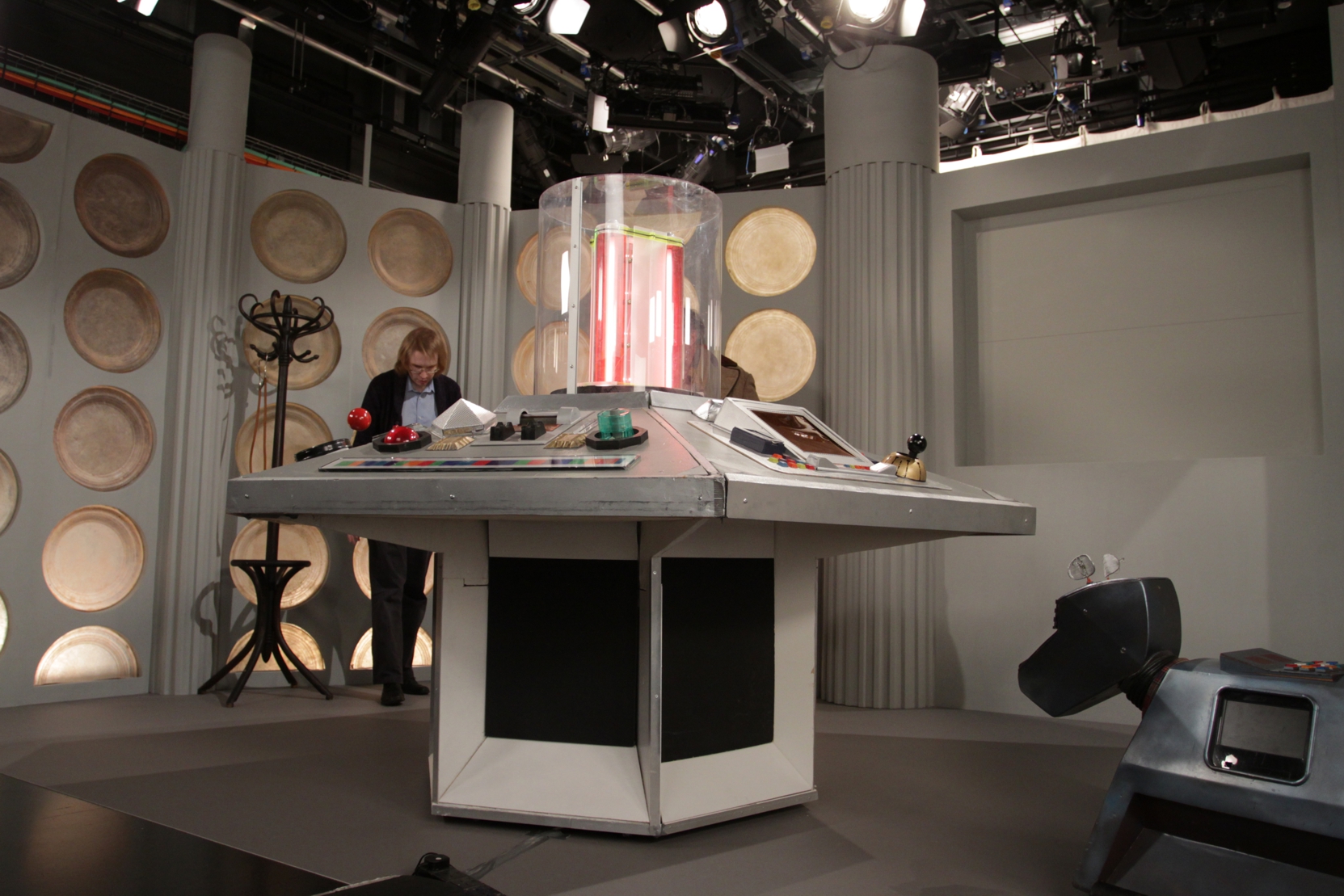
(Image © John Kelly)
We didn't want to have Tom Baker lying on a concrete floor for ages, as we shot this material, so we brought in Tim Bentinck to body-double for him again. We'd scheduled the day so that Tim would still be around in the afternoon, after having shot his green-screen work in the morning.
The costume also came from the Doctor Who exhibition in Cardiff and was another Mark Barton Hill creation. He'd apparently spent a lot of time getting the scarf just right.
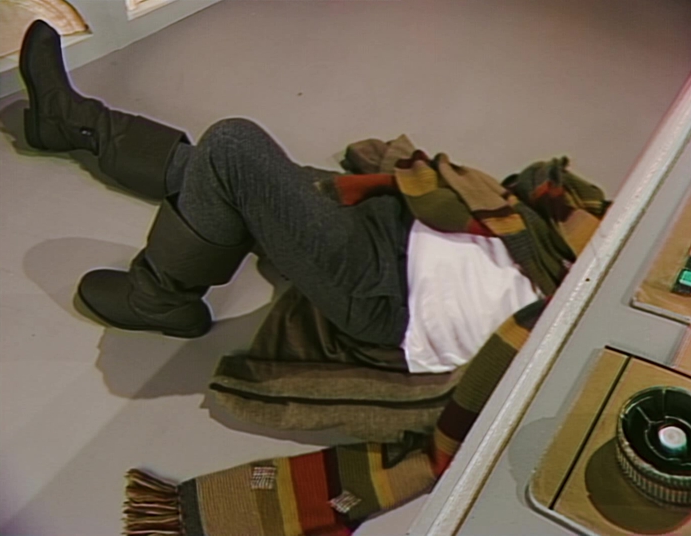
The K9 prop is the original one from the 1970s, operated by Mat Irvine again. The explosion was set-up by Mike Tucker. It was some kind of squib device that I forget the name of now. We had to give the studio staff early warning of it, so they could switch off the fire-alarm and sprinklers for a moment. The studio was normally used for magazine style shows. I think Sky Sports were in the studio next door to us. As such, pyrotechnics were a bit out of the ordinary for them. Incidentally, as originally scripted, K9 had a line in this scene. However, as we didn't have David Brierley to deliver it, I adjusted the script and gave the gist of the line to Tom instead.
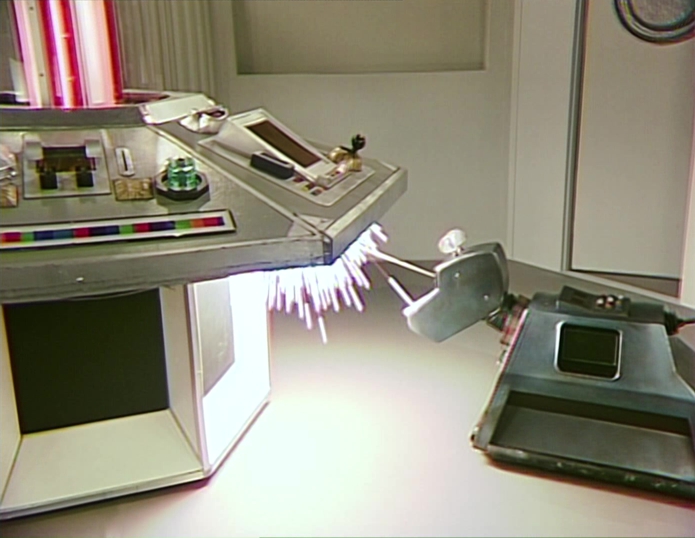
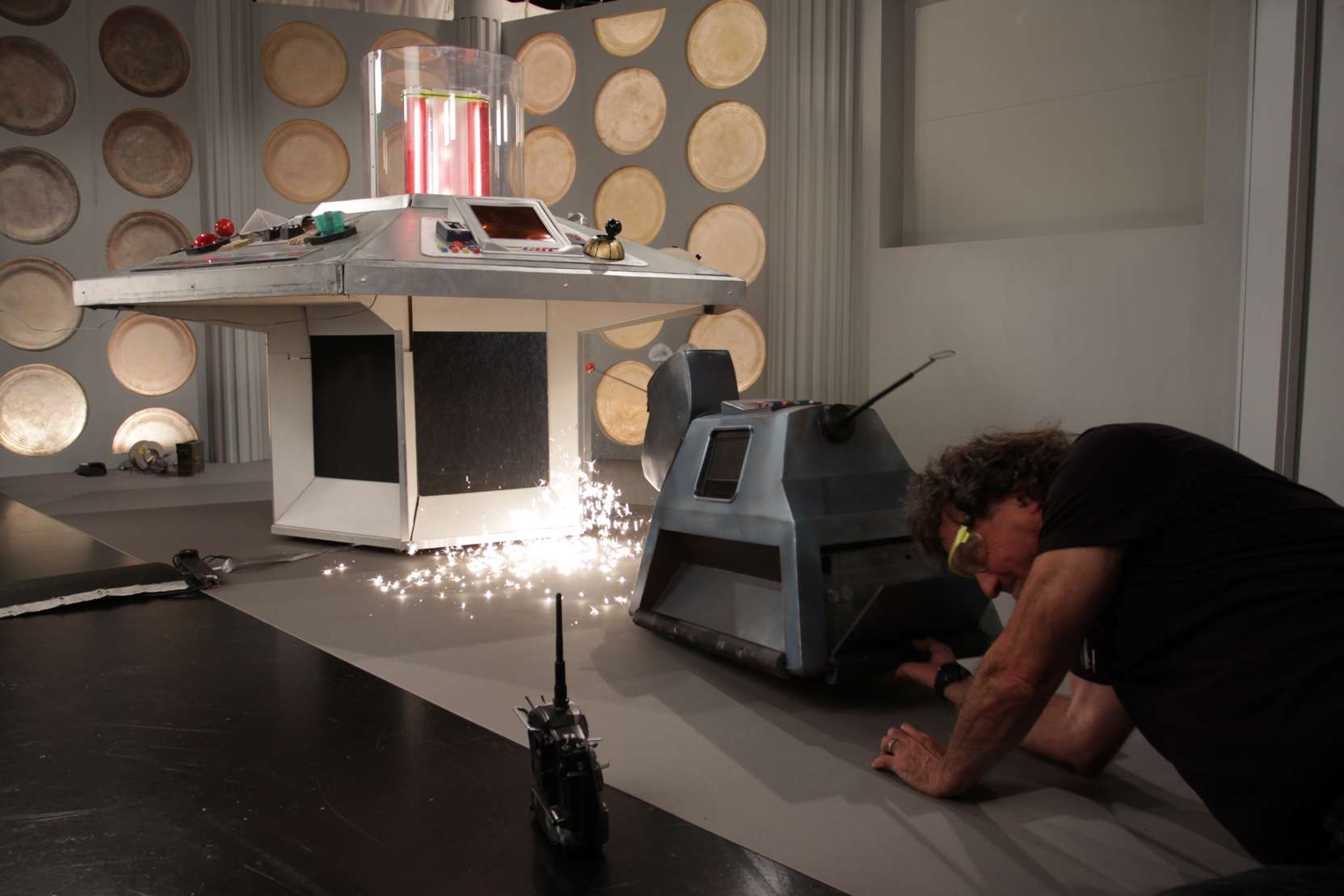
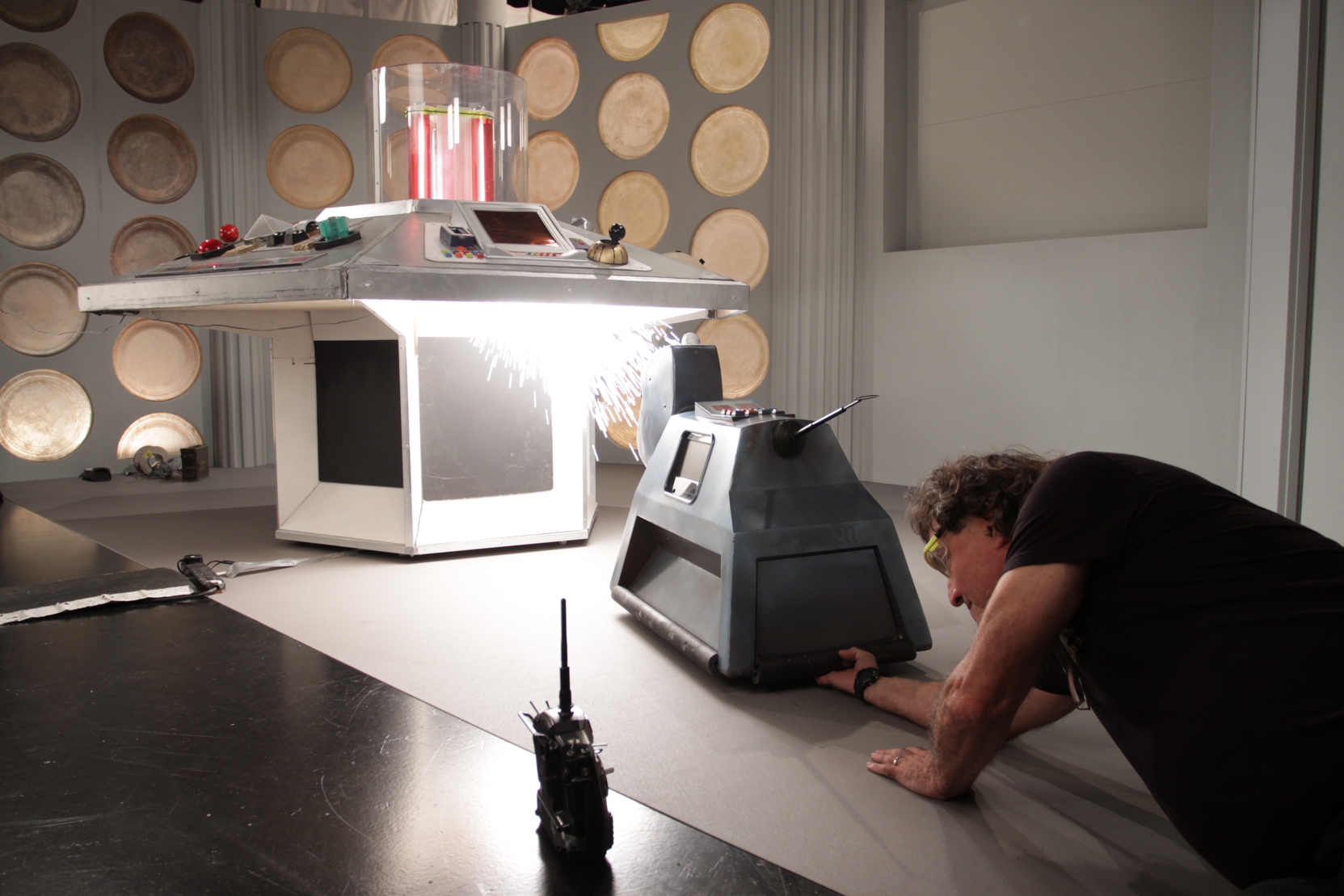
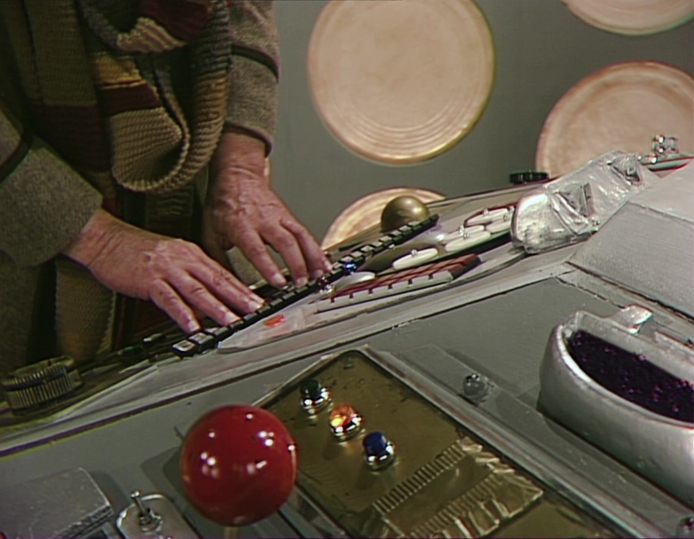
You probably think those are Tom's hands. They're not. It's actually Tim. I was originally going to cut the scene a bit differently, leaving Tim's body-double shot several frames earlier. However, I thought it actually worked quite well, to leave a few frames of Tim's hands in there. So, they're not Tom's hands, but they look enough like how you would expect Tom's hands to look in 2017, to give the viewer a hint of what's to come.
The original plan was that Romana would stick her head round the door at this point, giving you another little early warning build-up to what's about to happen in the final shot. We planned to shoot Lalla on the set in the morning, with Tom's half of the scene shot in the afternoon. Sadly, we were not able to arrange this and so we just cut to the open door, with Lalla's audio coming in out of shot. It's a nod to a similar scene in another Doctor Who story - Destiny of the Daleks.
The audio of Romana was recorded during the main dialogue recording sessions at Motivation Sound on of 26th June. It was the last thing Lalla recorded that day actually (and so, also the last thing she recorded for Shada as a whole).
The corridor that you can see beyond the door is actually a lot shorter than it might seem. It literally only extends as far as you can see. It's just a single column of roundels, carefully positioned to cover the gap formed by the open door. If the camera moved a fraction of an inch to the right you'd see the studio wall, with Mike Tucker holding the roundels steady, to stop them wobbling in the breeze.
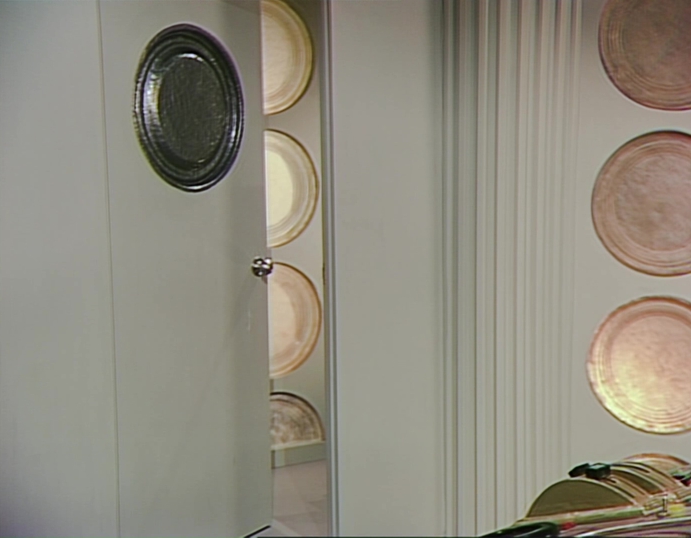
And there he is. I seem to recall that we did three takes of this last shot, although one of those was just Tom having some fun. It was a tense day - a lot to get through. I think we all knew that this would probably be the last time Tom put that costume on and to play the Doctor on camera. And I think Tom knew that too. I suspect that was at least part of the reason he did it.
It all put a certain pressure of expectation on things. It felt important. Tom was Tom, of course. All the stories you've heard are true. It's not easy. However, it is worth it. Without reservation, worth it. Tom genuinely cares very deeply about the performance he is giving. The part really matters to him and always has. And any arguments there might be (and we really didn't have any serious ones on Shada) come from that place - come from a place of wanting to get it right - knowing a part so well that you just know what works about it and what doesn't. And you don't want to let down the people that you know love that character.
Tom actively works at his Doctor. After forty-odd years, he could well have just phoned it in and I don't think any of the fans would have even minded too much. But he didn't.
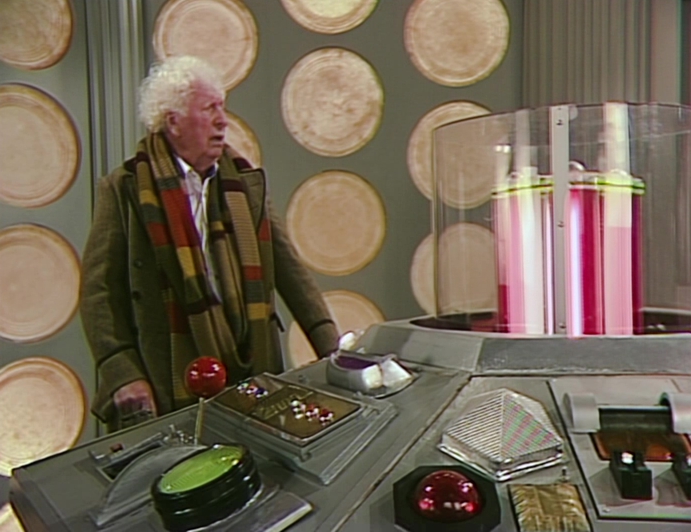
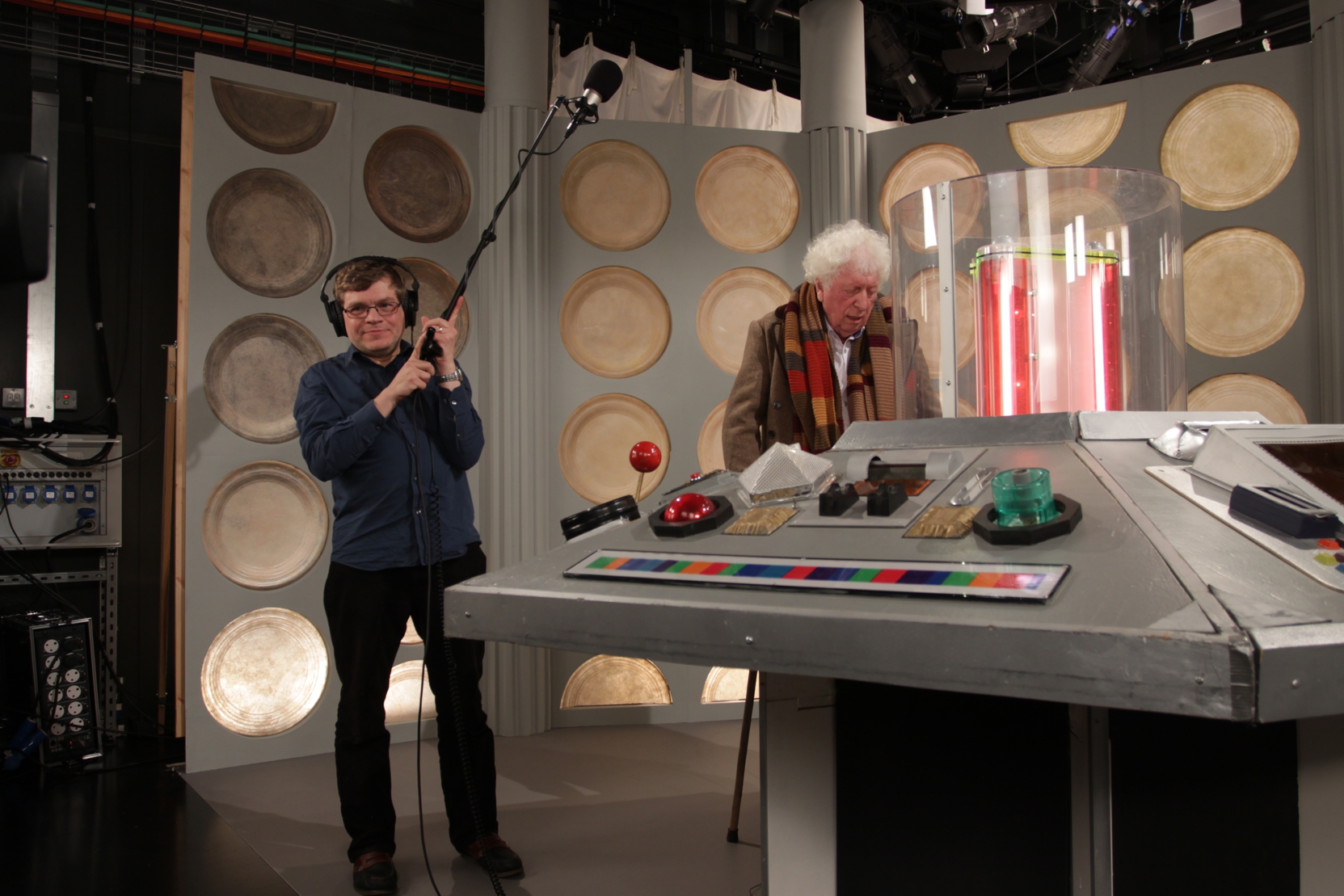
The only major regret with that scene was that we sadly were not able to keep it a surprise. Everyone had worked very hard throughout the production to keep that last scene a secret. Indeed, the surprise of it was one of the main reasons Tom had agreed to take part at all. And it was certainly the main reason I'd wanted to do it. However, just a few days after Shada was delivered, I was informed that the PR team had viewed the programme and had decided to use Tom's surprise appearance as the cornerstone of a promotional campaign. A special press-screening took place on 23rd November at which the final scene was shown to those in attendance.
Somewhere around this point in the end credits, there really should have been a compositing credit for Michael Dinsdale. And unforgivably, there isn't. Michael joined us very late when the compositing workload was starting to become a bit too much for Rob Ritchie alone and we needed to bring in a second compositor to help with the space-walk scenes. And it was so late in the day that Michael joined us, that we'd already finished compiling the end credits roller. And we didn't realise our omission until it was too late to redo them.
• MARK AYRES:
Hm. As I read the above, I am reminded that we did not actually remake the closing credits for the movie in 2021, as had been discussed. In the end I left them as they were. But Michael is credited on Part 6 of the six-part version. Indeed, I’ve just checked, to make sure, and I notice that he is credited twice (in error!). I suppose it makes up for missing out first time. Oops and oops. The six-part version also corrects the spelling of AnneMarie Walsh (she is mis-credited as “Anne Marie” on the movie.
• CHARLES NORTON:
German language closing credits were also prepared for Shada. These were prepared in the summer of 2021 - designed to accompany the forthcoming German dubbed version that was then being prepared by the Polyband company. This German language release was another reason behind us revisiting the Shada master to fix some grading and frame-rate errors. The job of actually translating the credits into German was a time-consuming one, as a number of job-titles that existed at the BBC in 1979, have simply never existed in the German film and television industry. In order to try and get the translations to work, I borrowed some terms from other German professions, but they're not always perfect equivalents.
• RICHARD BIGNELL:
The 2021 six-part version on the Season 17 Collection Blu-ray also includes one other credit not present on the original 2017 version. Back in 1979, the original plan was that the last episode would feature a credit thanking Emmanuel College for their help in the making of the story. Graham Williams' preferred wording for this was changed by Graeme MacDonald when the request for the caption was passed to him in his role as Head of Series and Serials, but the 2021 credits reinstates the acknowledgement the way Williams originally intended.
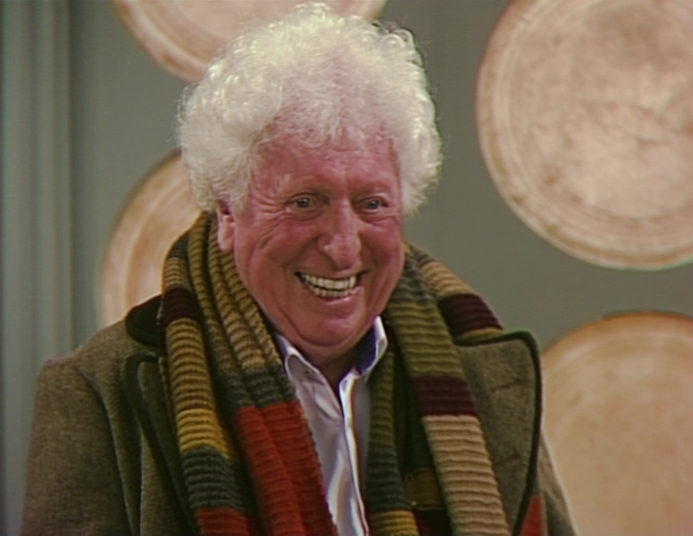
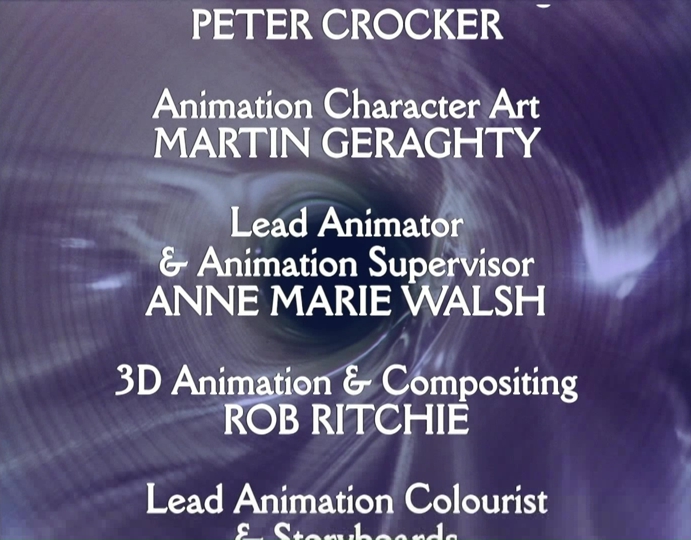
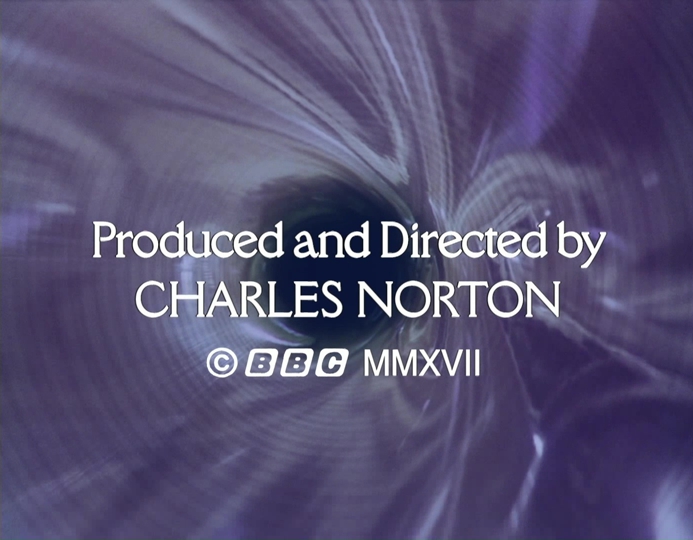

A couple of after-notes. In spite of all the edits we made to Shada during production - all the scenes we lost or trimmed - the final production is still over long. It's even around two minutes longer than it should have been had it been completed as a six-part serial back in 1979 and it's close to 45 minutes too long to fit the four-part serial format they planned for 1981. It's clear that regardless of how the original production team might have completed Shada back in the day, they would have been forced to cut not just as much of the script as we did, but significantly more than we did.
Oh, and finally: It didn't spoil the special-ness of Tom returning to the part. However, the final day of shooting didn't terminate quite as originally planned. After we'd competed that last shot with Tom (which was also the last shot of the day), I popped out from the studio floor to say goodbye to him and see him back to his car. This was the car that we'd specially hired to collect him and take him back home. And we got outside and... no car. We phoned the hire firm and they'd misunderstood the booking. They didn't know we wanted him taking back home. They thought they were just ferrying him there in the morning. It took about an hour to find a replacement service. During which time, myself and Paul Hembury did our very best to persuade Tom that we weren't utter idiots and that we would absolutely promise to get him home. Paul was an absolute god-send here. For my part, I committed a cardinal sin and left the studio floor for far longer than I should have done, leaving the crew for the best part of twenty minutes, unsure if the studio day was over or not. I ran back as soon as I could, red-faced and out-of-breath and they were all very forgiving of my total absence at a crucial moment. However, I regret leaving them so long, even if I didn't really have much alternative in the circumstances. I should have made sure I had another person on hand ready to run off and check the car before shooting wrapped. But I didn't. Paul Hembury saved the day there. As he did throughout really. I have no doubt that the entire project would have never even happened without him.
• MIKE TUCKER:
Most of my crew are of a similar age, and almost all of us grew up watching Tom Baker’s Doctor and studying how the BBC VFX crew created their shots. Other episodes in that 1979 season of Doctor Who feature great effects work by designers I admire like Ian Scoones, Mat Irvine and Colin Mapson, so it has been a delight to get a chance to work on a show that slots into that era. Sadly, Dave Havard passed away a few years back, but I feel that we honoured his original designs, and I hope he’d be proud of the work we did.
SHADA:
1979 Production Code: 5M
2017 Production Code: ABTI118E/50
PRODUCTION DATES:
15th October 1979 - Location Filming (Cambridge)
16th October 1979 - Location Filming (Cambridge)
17th October 1979 - Location Filming (Cambridge)
18th October 1979 - Location Filming (Cambridge)
19th October 1979 - Location Filming (Cambridge)
22nd October 1979 - Studio Filming - MOS (Ealing Film Studios)
3rd November 1979 - Studio Shoot (BBC Television Centre - Studio TC3)
4th November 1979 - Studio Shoot (BBC Television Centre - Studio TC3)
5th November 1979 - Studio Shoot (BBC Television Centre - Studio TC3)
19th November 1979 - Studio Shoot - Abandoned (BBC Television Centre - Studio TC6)
30th November 1979 - Production on Shada indefinitely suspended.
25th June 1980 - Production on Shada formally cancelled by the BBC.
Early 1992 - Completed footage from Shada edited into a 100-minute compilation presented by Tom Baker. The compilation is released commercially by BBC Video on 6th July 1992.
6th February 2017 - Tom Baker is formally approached to return to the rôle of the Doctor for two recording days, to complete Shada. Meeting takes place at BBC Television Centre between executive producer Paul Hembury, director Charles Norton and Tom Baker. It is at this meeting that Baker provisionally agrees, subject to contract. Work essentially then starts immediately, even though the project will not be green-lit until much later in the year.
24th April 2017 - Storyboarding Meeting (BBC Leicester)
18th May 2017 - Production Meeting (BBC Television Centre)
25th May 2017 - Production Meeting (BBC Television Centre)
6th June 2017 - Rotoscope Footage Session - MOS (Camberwell Studios)
9th June 2017 - Dialogue Recording Session (Audio Sorcery Studios)
13th June 2017 - Telecine Session (R3Store)
17th June 2017 - Production Meeting (BBC Television Centre)
19th June 2017 - Production Meeting (BBC Television Centre) and recce at Motivation Sound Studios, London.
22nd June 2017 - Christopher Neame is flown out of LA, a few days ahead of his studio recording day.
26th June 2017 - Dialogue Recording Session (Motivation Sound Studios)
8th July 2017 - Christopher Neame flies back to LA
17th July 2017 - Production Meeting (BBC Television Centre)
8th August 2017 - Model and VFX Filming - MOS (Halliford Studios - Stage 1)
9th August 2017 - Model and VFX Filming - MOS (Halliford Studios - Stage 1)
14th August 2017 - Production Meeting (BBC Television Centre)
29th August 2017 - Telecine Session (R3Store Facilities House)
12th September 2017 - Rigging and Set Build (IMG Studios, Uxbridge)
13th September 2017 - Final Studio Shoot (IMG Studios, Uxbridge)
18th September 2017 - Editing Day (BBC Television Centre - Edit Suite)
28th September 2017 - Editing Day (BBC Television Centre - Edit Suite)
11th October 2017 - Effects Shoot (Photographic Studio - Nuby UK)
25th October 2017 - Music Session (Masterchord Studios)
26th October 2017 - Music Session (Masterchord Studios)
6th November 2017 - Animation Production Completed
8th November 2017 - Dubbing Session (Mark Ayres Private Studio)
10th November 2017 - Final Delivery Deadline
13th November 2017 - QAR Technical Review (MX1 Facilities House, London)
23rd November 2017 - Press Screening (Curzon Cinema, Victoria, London)
24th November 2017 - Episode Released (Download to Own Platforms)
27th November 2017 - Tech Review Test Screening (BFI National Film Theatre, London)
2nd December 2017 - Public Screening (BFI National Film Theatre, London)
4th December 2017 - UK DVD/Blu-ray release (BBC DVD)
10th January 2018 - Australian DVD/Blu-ray release (BBC DVD)
5th June 2018 - Creation of new re-edit for commercial television (BBC Television Centre)
18th July 2018 - First Television Transmission (BBC America). Ratings place the show at number 136 in the US cable charts. It was the top rated BBC America show that day and the only BBC America show to place in the top 150. Just under a quarter of a million viewers (226,000) were recorded as watching the show on the night, according to overnight figures.
4th September 2018 - DVD/Blu-ray release - US and Canada (BBC DVD)
20th December 2021 - Season 17 Blu-ray Collection release (BBC DVD)
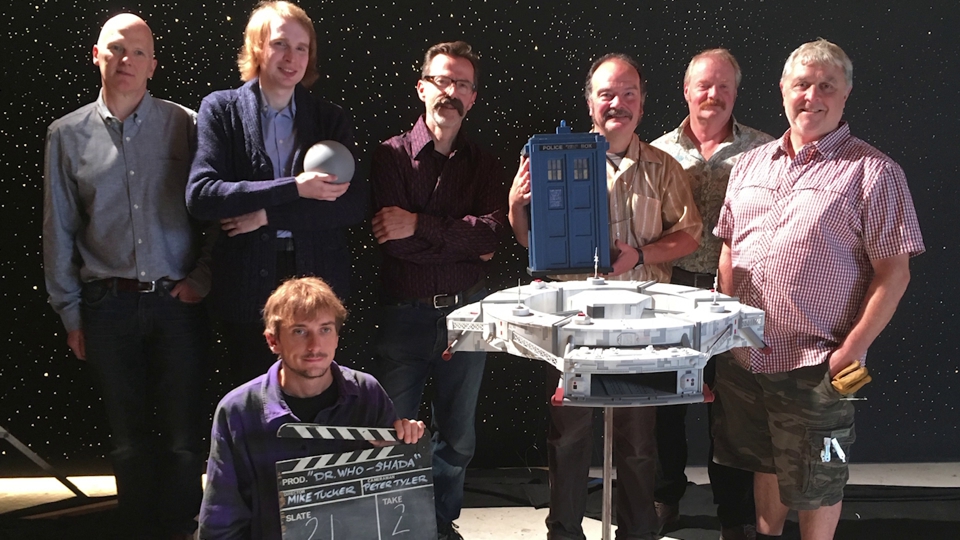
Peter Tyler (Director of Photography) and Alan Graham (Gaffer) Below: Chris Hayden (Camera Assistant) (Image © Karen Parks)
















